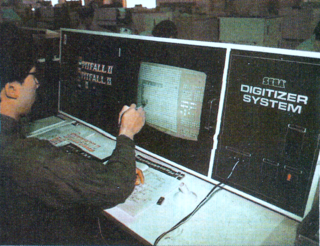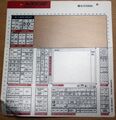Digitizer System
From Sega Retro
The Digitizer System is a piece of video game development hardware used by Sega during the 1980s and early 1990s. It was the primary means for Sega's artists to produce 2D images such as sprites and backgrounds, and is presumed to have been used for the vast majority of Sega games during this time period. It is assumed that three models exist, with the last being the Digitizer System III, however the existence of a "II" model has yet to be confirmed.
Much like a PC is a critical piece of equipment for today's artists, Digitizer Systems were the largest and most important thing on an artist's desk, comprising of two large screens and a number of inputs, such as floppy disk drives or ports for tablets. Original model Digitizer Systems came equipped with a light pen[1], however Mitablet-II KD4030[2] (equipped with a Z80, effective reading range, 380 mm x 260 mm) and KD4600[2] (equipped with a M68000, effective reading range, 460mm x 310mm) series digitizer tablets by Graphtec, using the computer-aided design (CAD) and drafting software application AutoCAD[3], were a standard with the Digitizer System III.
These types of tablets (Mitablet-II KD4030, KD4600) are essentialy low resolution digitizers, having a small work area that corresponds to the full CRT screen and are used for converting the physical locations into coordinate values for accurate data transfer. Very high resolutions in the order of 0.1mm or better can be achieved. Artists interact through a Puck, or pointer device, containing a coil which acts as a receiver or transmitter, and various functions can be assigned to its buttons, as needed.
The technology used by this kind of tablets is called, three-phase electromagnetic induction and the measurement is done alternatively in X-axis and Y-axis. The tablets communicate with the computer, in single-point mode, as the coordinates of the point are transmitted when a button of the Puck is pressed. This is used for digitizing discrete points such an already existing drawing. However, when continuous sets of points are required, the Puck can be moved continuously, over that line, and the coordinates of the points are sent to the computer at a specified sampling rate, such as 200 coordinate points per second (in the case of the Mitablet-II KD4030 digitizer, the speed rate is only of 52 points/sec in ASCII format, and 110/sec in Binary format).
Details of the systems' capabilites are not known, although it was possible to play back animations. It is said that they were linked up to NEC PC-9800 series desktops with hard disk drives in some way (permanent storage of programs and of data generated during various sessions of CAD requires a large amount of storage space).
Photo gallery
Digitizer System
Drawing the title screen of Pitfall II (System 1)
Yoshiki Kawasaki, 1984
Digitizer System III
Graphics for Golden Axe II (Mega Drive)
AutoCAD[4] Commands Overlay for digitizer tablets (Release 12, June 1992)













